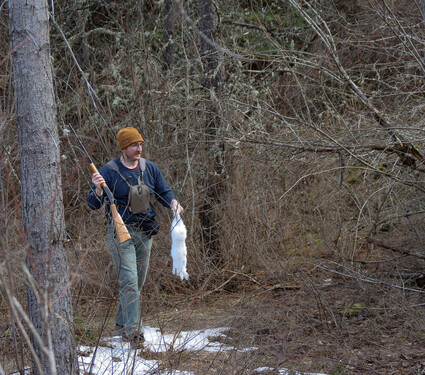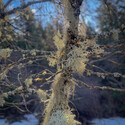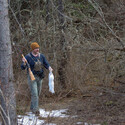Palouse Outdoors: Hunting Late-Season Snowshoe Hares
February 1, 2024

Brad Trumbo
Doug emerges from a tangle of classic rabbit cover, characterized by thick shrubs, brush, and thorny plants like rose and blackberry, where he found this large hare.
The end of the upland bird and waterfowl seasons in the early part of the calendar year comes with bittersweet closure, but as time ticks further beyond that last hunt, the urge to venture afield pulls harder, like an increasing magnetic force. Fortunately, small game seasons often run into March, bridging that early spring gap before the wild turkey opener. Early March can be a fine time to venture afield, with bluebird days forecasting imminent spring weather, which is precisely why I seek the mixed timber stands when the March sun breaks through the Washington freezing fog.
Snowshoe hares are one of the most abundant and well-distributed mammals in North America and are among the small game that can be hunted after other seasons close. They inhabit coniferous and boreal forests throughout the Pacific Northwest, New England, Alaska, Minnesota, Michigan, and Montana. However, hunting snowshoe hares comes with its challenges, like accessing high-elevation habitat.
Six feet of snow piled atop the Forest Service gate, separating my friends Doug, Rob, and me from our mountaintop destination. With snowshoes, it would have taken the rest of the day to make the hike, which is typically another thirty minutes by vehicle on a summer day. Walking to the rig behind me, I smirked through the window.
"What do ya think? Chain up and give it hell?" I asked wryly.
"You first!" Doug replied with a nervous chuckle.
The wall of snow required the quick formulation of "Plan B," which necessitated creativity. Also, Rob didn't have snowshoes, which meant we would have to stay low in elevation. We would leave the deep forest, circumvent a mountain range, and work up the adjacent drainage bottom, although I was skeptical of finding hares below 3,000 feet.

The snow had mostly melted in the creek bottom, save for the toe of the eastern slope, which contained the right mix of ferns, fruiting shrubs, and blackberry, packed tight against a steep hillside that was shaded by eroded basalt bands.
A gated road sliced through the middle of the narrow cover, which made the walking easy, but passing the one-hour mark with no hare sign led me to complacency. I slipped into the clutches of Mother Nature's charm, hypnotized by golden sun rays streaming through dark timber. Starbursts of sunlight glistened through water droplets that hung delicately from seafoam-tinted fruticose lichens. Steam rose from thawing frost. The stunning details held my attention as Doug and Rob focused on the hunt.

A short distance ahead, Rob walked a line through the thicket where raspberry, rose, and ferns created a dense ground cover. The faint metallic "click" of a gun safety roused my attention while a snow-white hare bounced across the trail directly between Doug and me, leaving us staring at one another in disbelief.
Doug melted into the timber behind the hare while I back-tracked to find an opening in the greenery. A sudden bark from Doug's Ithaca .410 single-shot echoed within the tight fir canopy, and he soon reappeared with a wide grin, carrying a beautiful young hare.
"It took me a moment to figure out why the snow was moving," Rob said with a laugh as he emerged from the briars and ferns opposite Doug and me. Had the hare not run our way, it may have been Rob's bunny.
We marveled over the silky softness of the hare's flawless winter coat and poked fun at its comically large hind feet. A critter well equipped to thrive in deep snow and evade predators like Canada lynx, bobcats, and coyotes.
Doug swapped places with Rob and moved quickly to the snowy toe of the slope. Moments later, the sudden discharge of his shotgun startled Rob and me. A second hare sat conspicuously beneath a fir just above head height on the slope as Doug approached-a reward for being at the right place and time.
We called the hunt with two hares in the bag and shared a jovial hike out beneath the warming late-morning sun. That first hunt taught us that elevation is not a singular element in finding hares. The right habitat can be shrubby creek bottoms, given hares eat twigs, buds, and bark in winter. A mix of deciduous and coniferous forest stands offer a good variety of food sources and covers.

Look for "browse lines" where hares create trails in heavy snow. Always have a "Plan B," as conditions and access can change yearly. And never forget your snowshoes.




Reader Comments(0)